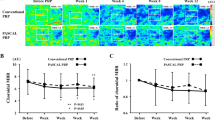Abstract
Eyes with three or four diabetic retinopathy risk factors received laser panretinal photocoagulation with random selection of either blue-green argon (42 eyes) or red krypton (40 eyes) laser to determine if one laser was superior to the other. After 6 months, visual acuity preservation or improvement was obtained in 33 (79%) argon- and 34 (84%) krypton-treated eyes. Peripheral IV-4e visual field constriction of 7% occurred with argon and 10% with krypton. Vitreous hemorrhaging after treatment occurred in 1 argon- and in 6 krypton-treated eyes. Complete disc neovascular regression was obtained in 27 (67%) of 40 argon- and 19 (56%) of 34 krypton-treated eyes, with partial regression occurring in 8 (20%) argon- and 8 (24%) krypton- treated eyes. The two treatments produced essentially equal results.
Similar content being viewed by others
References
Aiello LM, Beetham WP, Balodimos MC, Chazan BI, Bradley RF (1968) Ruby laser photocoagulation in treatment of diabetic proliferating retinopathy: preliminary report. In: Goldberg MF, Fine SL (eds) Symposium on the Treatment of Diabetic Retinopathy, Airlie House, Warrenton, Virginia, September 29 to October 1, 1968. Washington DC: US Government Printing Office (PHS Publication no. 1890), pp 437–463
Barr CC (1984) Estimation of the maximum number of argon laser burns possible in panretinal photocoagulation. Am J Ophthalmol 97: 697–703
Blankenship GW (1982) Panretinal laser photocoagulation with a wide-angle fundus contact lens. Ann Ophthalmol 14: 362–363
Diabetic Retinopathy Study (1972) Manual of operations. Baltimore: DRS Coordinating Center, Department of Epidemiology and Preventive Medicine, University of Maryland School of Medicine
Diabetic Retinopathy Study Research Group (1976) Preliminary report on effects of photocoagulation therapy. Am J Ophthalmol 81: 383–396
Diabetic Retinopathy Study Research Group (1978) Photocoagulation treatment of proliferative diabetic retinopathy; the second report of diabetic retinopathy study findings. Ophthalmology 85: 82–106
Diabetic Retinopathy Study Research Group (1979) Four risk factors for severe visual loss in diabetic retinopathy; the third report from the Diabetic Retinopathy Study. Arch Ophthalmol 97: 654–655
Doft BH, Blankenship GW (1982) Single versus multiple treatment sessions of argon laser panretinal photocoagulation for proliferative diabetic retinopathy. Ophthalmology 89: 772–778
Doft BH, Blankenship GW (1984) Retinopathy risk factor regression after laser panretinal photocoagulation for proliferative diabetic retinopathy. Ophthalmology 91: 1453–1457
Frank RN (1975) Visual fields and electroretinography following extensive photocoagulation. Arch Ophthalmol 93: 591–598
L'Esperance FA Jr (1972) Clinical photocoagulation with the krypton laser. Arch Ophthalmol 87: 693–700
Okun E (1968) The effectiveness of photocoagulation in the therapy of proliferative diabetic retinopathy (PDR); (controlled study in 50 patients). Trans Am Acad Ophthalmol Otolaryngol 72: 246–252
Okun E, Johnston GP, Boniuk I, Arribas NP, Escoffery RF, Grand MG (1984) Xenon arc photocoagulation of proliferative diabetic retinopathy: a review of 2.688 consecutive eyes in the format of the Diabetic Retinopathy Study. Ophthalmology 91: 1458–1463
Schulenberg WE, Hamilton AM, Blach RK (1979) A comparative study of argon laser and krypton laser in the treatment of diabetic optic disc neovascularisation. Br J Ophthalmol 63: 412–417
Singerman LJ (1982) Red krypton laser therapy of macular and retinal vascular diseases. Retina 2: 15–28
Singerman LJ, Ferris FL, Passloff RW (1983) Red krypton laser (RKL) and blue-green argon laser (BGAL) treatment of proliferative diabetic retinopathy (PDR) with neovascularization of the disc (NVD). ARVO Abstracts. Invest Ophthalmol Vis Sci [Suppl] 24: 172
Wessing AK, Meyer-Schwickerath G (1968) Results of photocoagulation in diabetic retinopathy. In: Goldberg MF, Fine SL (eds) Symposium on the Treatment of diabetic retinopathy, Airlie House, Warrenton, Virginia, September 29 to October 1, 1968. Washington DC: US Government Printing Office (PHS Publ. no. 1890), pp 569–592
Author information
Authors and Affiliations
Additional information
Supported in part by patients of and contributors to the Bascom Palmer Eye Institute, Research to Prevent Blindness, Inc., New York, Florida Lions Eye Bank, and the Brenn Green Diabetic Retinopathy Fund, Miami, Florida
Rights and permissions
About this article
Cite this article
Blankenship, G.W., Gerke, E. & Batlle, J.F. Red krypton and blue-green argon laser diabetic panretinal photocoagulation. Graefe's Arch Clin Exp Ophthalmol 227, 364–368 (1989). https://doi.org/10.1007/BF02169414
Received:
Accepted:
Issue Date:
DOI: https://doi.org/10.1007/BF02169414




